Ramkot Fort
| Ramkot Fort | |
|---|---|
Azad Jammu and Kashmir | |
| Construction started | 16th century AD |
Ramkot Fort (
History
The fort was constructed in 1186 during the Ghurid dynasty by Sultan Ghiyas-ud-din, according to the information board at the entrance but that fort is no longer in existence.".[3] In the late 14th century, the fort was under control of Jasrat, a Punjabi Khokhar chieftain. At this fort Khokhars clashed with the armies of amir Timur in 1398.[4] However, the current structure probably dates to the 16th century builted by Kashmir Sultanate.[5][6]
A temple with a large red
Ramkot Fort held strategic importance, as one of the four ancient routes to Srinagar passed through it.
Architecture
The main gate, constructed with red bricks, contrasts with the stone used elsewhere, suggesting possible destruction and reconstruction.[3] A smaller gate at the back was likely used for escape.[3]
The fort's interior features two large ponds for rainwater collection, essential due to its elevation and previous location at the confluence of the Jhelum and Poonch rivers.[3] Collapsed rooms, raw iron deposits, and the superintendent's residence are found within the complex.[3] The fort also includes a slope for hauling cannons, with a donated cannon on the rampart.[3]
Gallery
-
Landscape view
-
Bird's eye view
-
Courtyard
See also
- List of UNESCO World Heritage Sites in Pakistan
- List of forts in Pakistan
- List of museums in Pakistan
References
- ^ "Fort forlorn and forsaken | Footloose". The News International.
- ^ "Ramkot Fort: Centuries-old Kashmiri heritage site on the verge of destruction". The Express Tribune. January 29, 2012.
- ^ Independent Urdu. February 19, 2021.
- ISBN 978-81-260-0365-5.
- ^ Ali, Aown (July 3, 2015). "Ramkot Fort: The crumbling giant of Azad Kashmir". DAWN.COM.
- ^ "Ramkot Fort, Mirpur, Pakistan". Asian Architecture.




